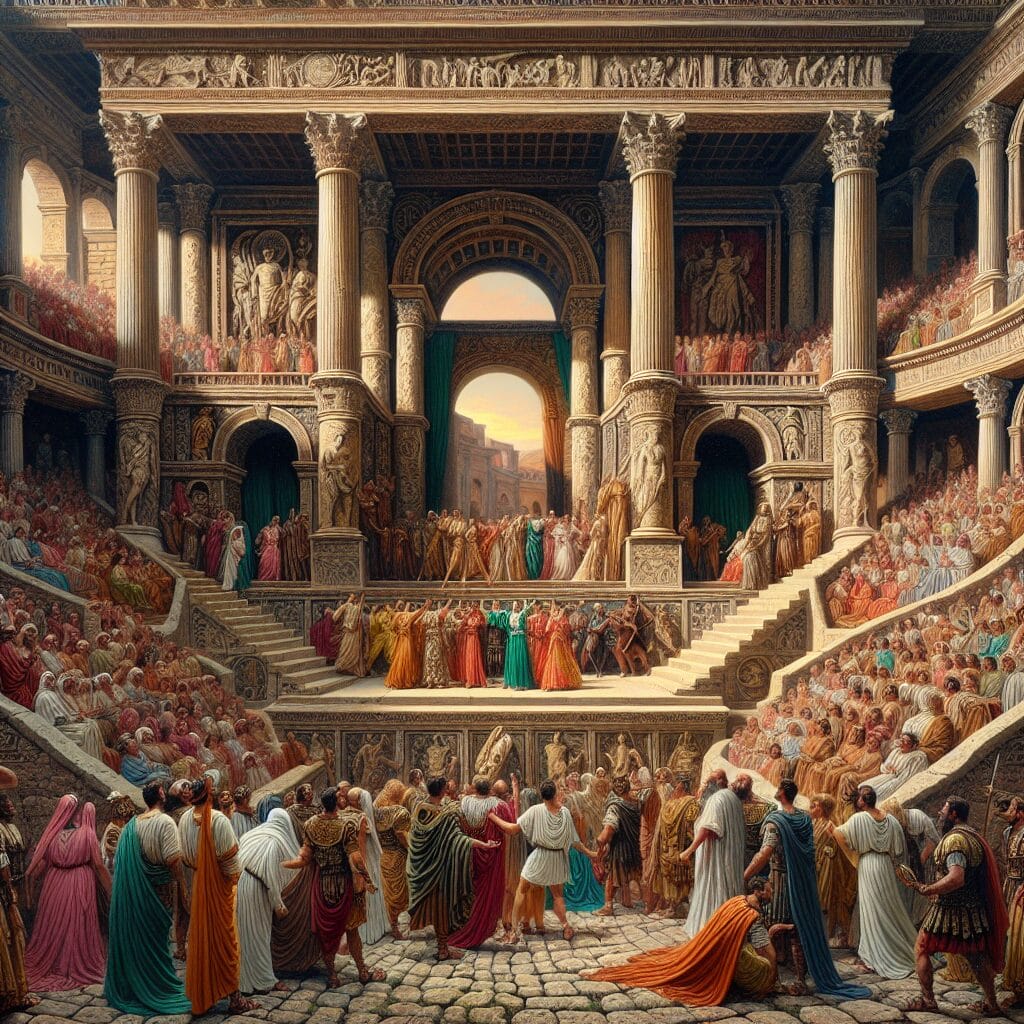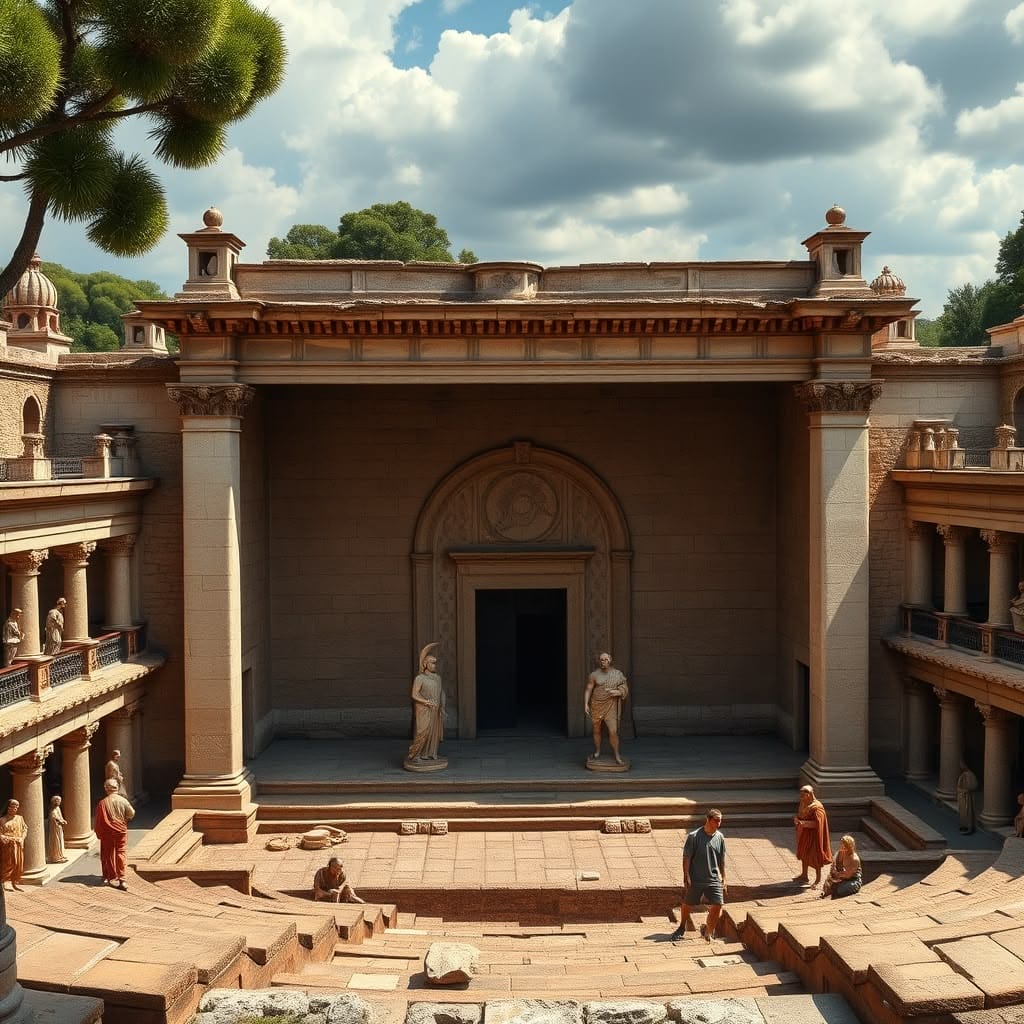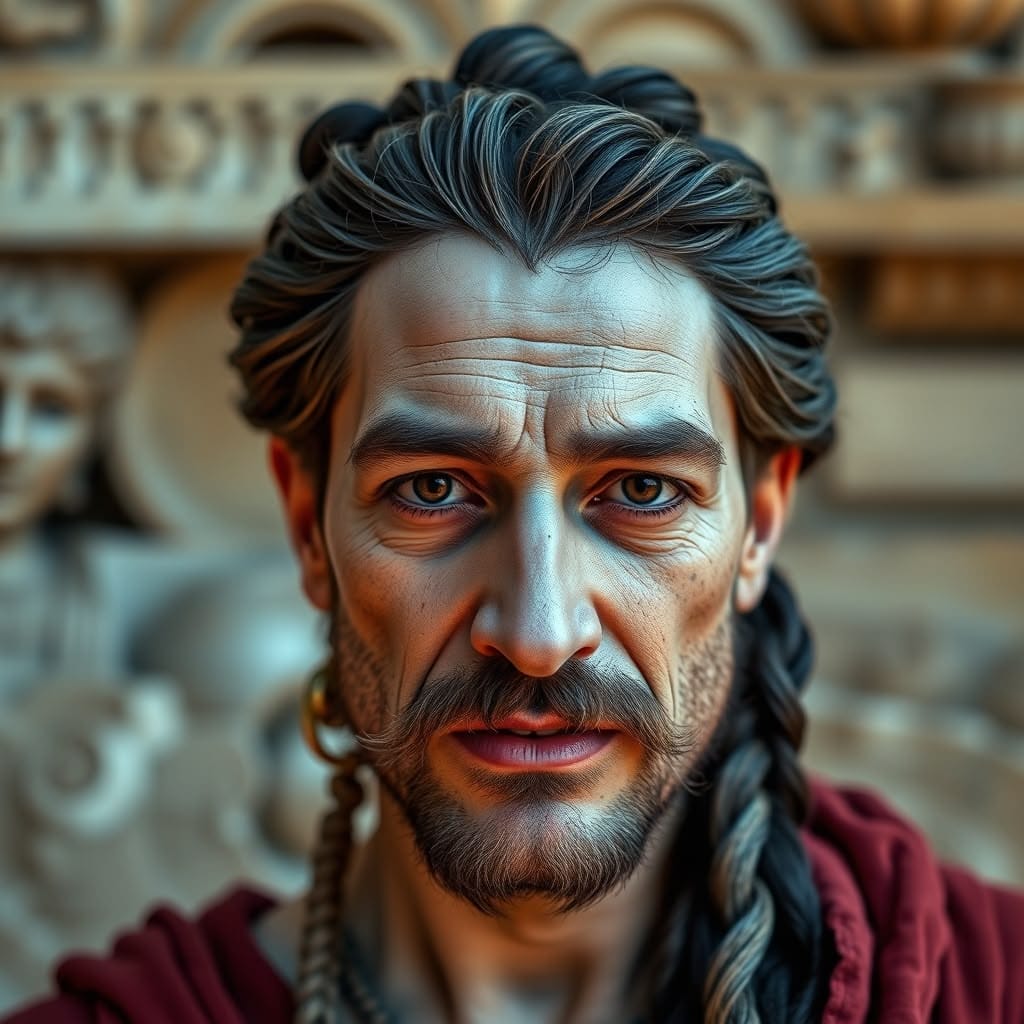Roman theaters played a pivotal role in the cultural landscape, serving as venues for entertainment that captivated both the elite and the common populace. These spaces were not merely for amusement; they were arenas of social commentary, reflecting and satirizing the intricacies of Roman society and politics.
This article delves into the evolution of Roman theater from its Greek origins, examining how it adapted and flourished. By exploring comedy, tragedy, and the notable figures within this domain, we aim to highlight the multifaceted nature of Roman theatrical arts.
Greek Influence on Roman Theater

Roman theater owes much of its foundation to the rich traditions of Greek theater, particularly the genres of comedy and tragedy. The Romans adopted these genres, infusing them with Roman themes and societal issues. This adaptation allowed for a more relatable narrative for Roman audiences, often focusing on local history and politics.
However, the Romans were not mere imitators; they introduced several modifications to Greek theater practices. Architecturally, Roman theaters were often freestanding structures, unlike their Greek counterparts, which were typically built into hillsides. This design choice facilitated more elaborate and decorative theaters, enhancing audience capacity and visibility.

Performance styles also evolved, with Romans placing a greater emphasis on spectacle and entertainment. This shift was evident in their use of more elaborate costumes and masks, as well as the incorporation of special effects through stage machinery. The Romans expanded theatrical genres to include farce and pantomime, further diversifying the theatrical experience.
Through these adaptations, Roman theater emerged as a distinct yet deeply enriched art form, reflecting both its Greek roots and the unique cultural context of Rome.
Evolution of Roman Comedy
The evolution of Roman comedy is a fascinating narrative of cultural adaptation and innovation. Originating from ancient Greek comedic traditions, Roman playwrights molded these influences into a distinctive genre. The transformation involved incorporating Latin and local settings, which made the plays more relatable to Roman audiences. This shift was marked by the introduction of stock characters, such as the clever slave and the braggart soldier, which became staples in comedic narratives.

Prominent playwrights were instrumental in shaping this genre. Plautus, often regarded as the father of Roman comedy, was known for his lively characters and clever wordplay, creating enduring works like ‘Miles Gloriosus’. Meanwhile, Terence, a former slave, brought a refined style and complex character development to the Roman stage with plays such as ‘Andria’.
These playwrights not only entertained but also offered social commentary through humor, reflecting the norms and politics of Roman society. This blend of Greek influence and Roman creativity laid the groundwork for future theatrical traditions, leaving a lasting legacy in Western literature.
Tragedy in Roman Theaters
Tragedy in Roman theaters owes much of its foundation to the classical Greek influences, particularly the works of dramatists like Aeschylus, Sophocles, and Euripides. These Greek tragedies offered profound explorations of human nature, fate, and the divine, themes that Roman playwrights embraced and adapted to reflect their own societal values and historical context.

While Greek tragedies often focused on mythological narratives and the interplay between humans and gods, Roman tragedies frequently emphasized moral dilemmas and human emotions. This shift allowed Roman tragedies to resonate deeply with audiences, addressing themes of power, honor, and the complexities of the human condition.

Among the key figures in Roman tragedy, Seneca stands out as a pivotal playwright. Known for his philosophical depth and exploration of Stoic themes, Seneca’s works often delved into the darker aspects of human nature and morality. His tragedies, such as ‘Phaedra’ and ‘Thyestes’, are noted for their intense psychological insight and dramatic tension.
In essence, Roman tragedy, while rooted in Greek tradition, evolved into a distinctive art form that reflected the complexities of Roman society, leaving a legacy that influenced the development of later Western literature.
Social Commentary Through Theater
Roman theater served as a powerful medium for satire, providing a platform to critique societal norms and political issues. Playwrights like Plautus and Terence ingeniously used comedic elements to expose the absurdities of political life and social inequality. Through humor and exaggeration, their plays addressed themes of corruption and social class tensions, offering audiences a reflective mirror of contemporary Roman society.

Characters such as the cunning slave or the foolish old man became archetypal figures, enabling playwrights to subtly criticize the upper classes and their excesses. This clever use of satire allowed for political commentary that engaged audiences without direct confrontation. For instance, the depiction of corrupt politicians or greedy merchants in comedies served as a satirical reflection of the prevailing political landscape.
The impact of these performances on audiences was profound, as they not only entertained but also encouraged public discourse and critical thinking. By presenting relatable scenarios, Roman theater prompted citizens to question authority and reflect on their own societal values. This cultural reflection fostered a shared understanding among audiences, making the plays both thought-provoking and enduringly influential in shaping public opinion.
Actors in Roman Theater
The status of actors in ancient Rome was notably complex, characterized by a juxtaposition of admiration and disdain. Generally, actors were deemed to possess a low social standing, often relegated to the fringes of society. Despite their popularity, they were frequently stigmatized and considered morally questionable. Many Romans likened actors to untrustworthy professions, reflecting broader societal attitudes towards performance and entertainment.

Actors were often classified as infames, a legal status that limited their rights and excluded them from civic duties. This classification underscored the societal perception of acting as an unrespectable profession. However, some renowned actors managed to achieve a degree of wealth and public adoration, although such success rarely altered their social standing.
The involvement of slaves and freedmen in Roman theater was significant. Slaves, owned by patrons or theater managers, were trained to perform in various genres. Freedmen, former slaves who had gained freedom, also contributed greatly, often using their experiences to advance in the performing arts. Despite their contributions, both groups faced societal disdain. Nevertheless, their roles were crucial, providing a rich tapestry of talent that shaped Roman theater’s evolution.
Theater as a Political Tool
In ancient Rome, theater emerged as a powerful medium for political commentary, providing playwrights with a platform to address contemporary issues. Through the use of satire and humor, plays critiqued political figures and societal norms, reflecting the social and political climate of the time. This approach made complex political topics accessible and engaging to the general public, fostering discussions about governance and power dynamics.

Public engagement in Roman theaters was significant, as these venues were communal spaces where citizens gathered. As such, they became ideal for disseminating political ideas and encouraging public discourse. While specific examples of political plays are not well-documented, the impact of these performances on Roman society was profound. The popularity of certain plays could sway public sentiment, influencing support or opposition for political figures and policies.
Despite its potential for expression, theater was also subject to censorship and control by the state, which sought to manage the narrative and suppress dissent. Nevertheless, the tradition of using theater for political commentary has endured, illustrating the lasting influence of Roman cultural expressions on modern political discourse.
Architecture of Roman Theaters
The architecture of Roman theaters reflects a unique blend of aesthetic and functional design. Typically, these theaters featured a semi-circular cavea for seating, which optimized acoustics and visibility. At the heart of the theater lay the orchestra, a central area often semi-circular, positioned directly in front of the raised stage, or pulpitum. The stage backdrop, known as the scenae frons, was adorned with elaborate decorations, including columns and statues, which served as a focal point for performances.

Roman theaters were typically freestanding structures, a notable deviation from Greek theaters that were often built into hillsides. This freestanding nature allowed Roman architects to employ innovative engineering techniques, utilizing materials like stone and concrete to ensure durability and stability.
| Feature | Roman Theaters | Greek Theaters |
|---|---|---|
| Structure | Freestanding | Hillside |
| Seating Capacity | 20,000+ | Up to 15,000 |
| Materials | Concrete and Brick | Stone and Wood |
| Decoration | Ornate | Minimalistic |
These design choices not only enhanced the theater experience but also demonstrated the Romans’ architectural prowess, leaving a legacy that continues to influence modern theater design.
Audience Experience in Roman Theaters
Roman theaters were vibrant centers of entertainment, drawing in a diverse audience from across the social spectrum. These performances were attended by both the elite and common citizens, reflecting the inclusive nature of Roman public spectacles. Despite the diversity in attendees, the seating arrangements within these theaters maintained a strict social hierarchy.

The seating in Roman theaters was carefully organized to reflect the social status of the viewers. The best seats, located closest to the stage, were reserved for senators, magistrates, and other dignitaries, providing them with optimal views and acoustic advantages. Behind these elite sections sat the equestrian class, followed by the general populace, including the plebeians and freedmen. The uppermost tiers were often designated for women and slaves, underscoring the rigid class distinctions of the time.
This hierarchical seating arrangement not only showcased the social order but also served practical purposes by ensuring that the most influential citizens had prime access to the spectacles. Such arrangements in Roman theaters are a testament to the societal norms and values of ancient Rome, where social stratification was visibly reinforced in public spaces.
Economic Impact of Roman Theaters
Roman theaters played a pivotal role in stimulating local economies, serving as significant centers of economic activity. These venues attracted vast numbers of spectators, including both Roman citizens and visitors from different regions of the empire. Consequently, the influx of theatergoers spurred demand for various goods and services, bolstering businesses in surrounding areas. Local vendors thrived by selling food, drinks, and souvenirs to attendees, creating a bustling marketplace atmosphere around the theater premises.

Moreover, theaters provided employment opportunities for a wide range of individuals. From skilled laborers involved in the construction and maintenance of these grand structures to artisans who crafted the elaborate scenae frons and decorative elements, the economic ripple effect was considerable. Additionally, performances necessitated the presence of actors, musicians, and stagehands, many of whom were slves or freedmen, thus offering them a livelihood and a chance to gain social mobility.
The economic activities associated with Roman theater events extended beyond immediate employment and trade. These events also fostered a vibrant cultural exchange, attracting performers and audiences from various regions, thereby enhancing the economic and cultural vitality of the communities surrounding these monumental entertainment hubs.
Cultural Exchange Through Theater
Roman theaters served as vibrant hubs for cultural exchange, facilitating a blend of artistic traditions and ideas from diverse regions. As Rome expanded its territories, it absorbed various cultural elements from conquered lands, which were then reflected in the theatrical performances. This cross-pollination of cultural influences enriched Roman plays, infusing them with themes and narratives from foreign cultures.

Greek theater, renowned for its dramatic and comedic forms, played a significant role in shaping Roman theatrical practices. Romans adapted Greek styles, integrating local customs and preferences, which allowed for a unique fusion of theatrical expression. Additionally, the inclusion of performers and playwrights from different regions within the Roman Empire contributed to a wider variety of theatrical genres and styles.
Theaters themselves became venues where cultural integration was visibly displayed. Audiences from diverse backgrounds gathered to enjoy performances, creating a shared cultural experience that transcended regional differences. This blending of cultures through theater not only entertained but also fostered a sense of unity and understanding among the various peoples of the vast Roman Empire, leaving a legacy of cultural diversity within theatrical traditions.
Legacy of Roman Theater
The enduring legacy of Roman theater is evident in its profound influence on modern theater and film. Many contemporary theatrical structures and cinematic techniques draw inspiration from the architectural and artistic innovations pioneered by the Romans. The design aspects, such as the semi-circular seating and the intricate scenae frons, have been adapted in modern venues to enhance acoustics and visibility, demonstrating the lasting impact of Roman engineering.

Beyond architectural contributions, Roman theater also introduced enduring themes that continue to resonate in today’s arts. Themes such as social satire, political commentary, and the exploration of human nature were prevalent in Roman plays and have become staples in contemporary storytelling. These themes are often revisited in modern narratives, reflecting the timeless nature of the issues they address.
As a result, Roman theater has left an indelible mark on the cultural landscape. Its influence extends beyond just form and structure, shaping the content and purpose of the arts. The legacy of Roman theater continues to inspire and inform artistic expression, ensuring its relevance and vitality in the modern era.
Conclusion
Roman theaters played a pivotal role in ancient entertainment, blending comedy, tragedy, and social commentary. They evolved from Greek influences, adapting structurally and culturally to meet the needs of Roman society. This evolution resulted in architectural marvels characterized by their semi-circular designs and intricate decor.

Beyond architecture, Roman theaters were significant for their cultural contributions, influencing modern theater and film. Their legacy endures, underscoring the profound impact they had on both ancient and contemporary arts.
Frequently Asked Questions
- What were the main features of Roman theaters? Roman theaters were characterized by a semi-circular design, a central orchestra, and a decorated stage backdrop known as the scenae frons. They also featured advanced engineering techniques and multiple entrances for efficient crowd movement.
- How did Roman theaters differ from Greek theaters? While both were influenced by Greek designs, Roman theaters were typically freestanding structures with more elaborate decorations and larger seating capacities. They also hosted a wider range of entertainment, including gladiatorial games.
- What role did theaters play in Roman society? Roman theaters were central to entertainment, providing a venue for plays that often included comedy, tragedy, and social commentary. They were accessible to both elites and commoners, fostering a shared cultural experience.
- Who were the actors in Roman theaters? Actors in Roman theaters were generally of low status, often slaves or freedmen. Despite their social standing, they played a crucial role in delivering performances that sometimes carried subtle political messages.

